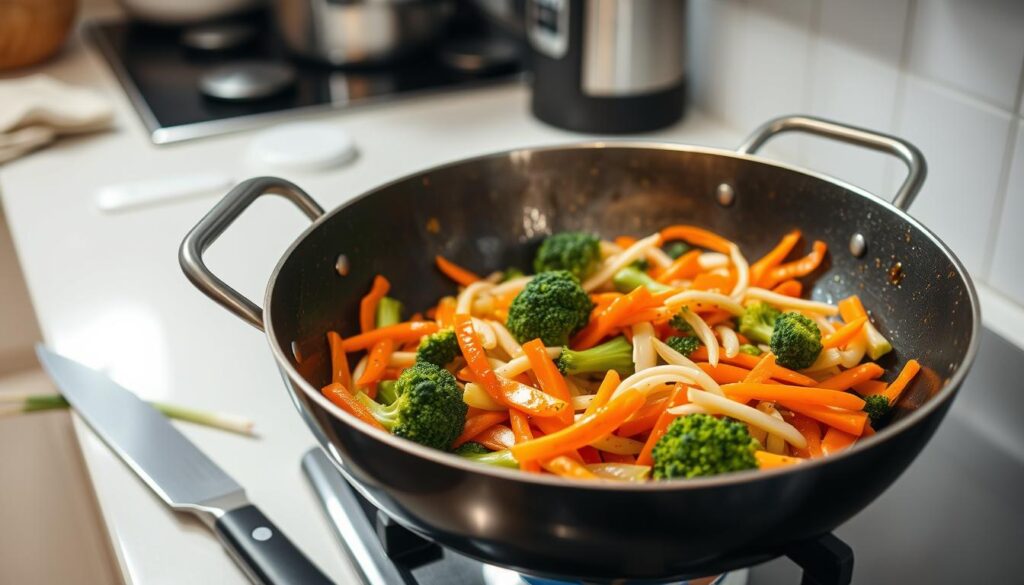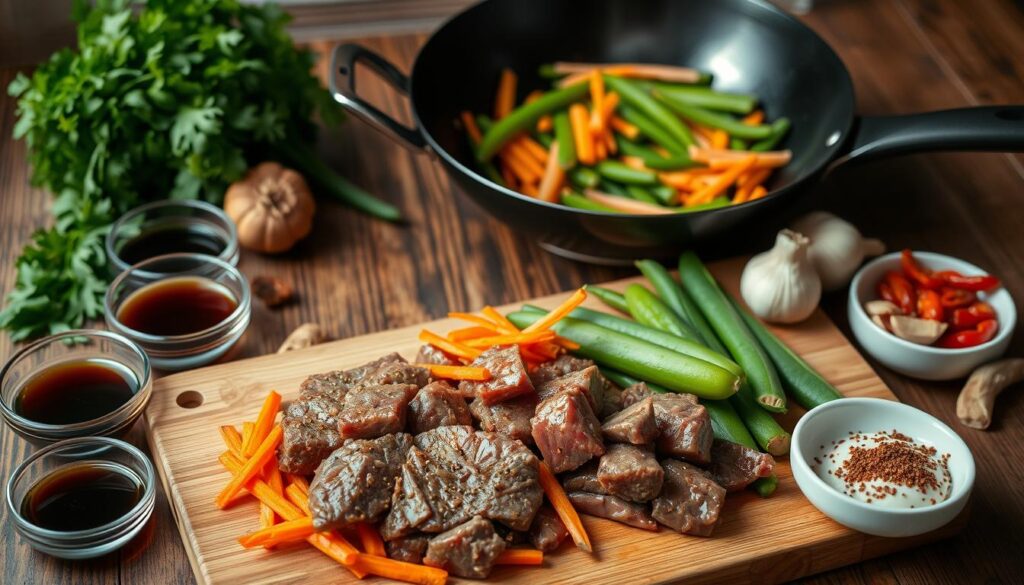I still remember the first time I stood in my kitchen, exhausted after a 12-hour workday, staring at a package of flank steak like it was a puzzle. Could I really turn this into something satisfying without spending hours cooking? That’s when I discovered the magic of combining simple techniques with bold flavors—a lesson that changed my weeknight dinners forever.
What makes this dish special isn’t just its speed (ready in under 30 minutes!), but how every bite feels like a warm hug. I use fresh broccoli and carrots for crunch, paired with a savory glaze that clings perfectly to thinly sliced meat. The secret? A cornstarch trick I learned from my grandmother, which creates that restaurant-quality texture we all crave.
You’ll love how forgiving this method is. Whether you’re using frozen veggies or experimenting with different cuts, the results stay consistently delicious. I’ve served this to picky eaters and foodies alike—it’s become my go-to when I want to impress without stress.
Key Takeaways
- Ready in 25-30 minutes with minimal cleanup
- Uses cornstarch for tender, restaurant-style meat
- Works with fresh or frozen vegetables
- Features a balanced sauce with soy sauce and aromatic spices
- Adaptable to different dietary preferences
A Quick Introduction to My Kitchen Adventure
Rainy evenings and empty fridges taught me the beauty of simple, fast cooking. My journey began during grad school—I’d race home between classes, craving something hearty but lacking time or energy. That’s when I discovered how a hot pan could transform basic veggies and protein into magic in minutes.

My Story with Stir-Fry
This dish became my edible love letter to efficiency. I’d toss whatever I had—bell peppers, snap peas, even leftover rotisserie chicken—into my trusty skillet. The recipe evolved through trial and error: too salty? Add honey. Soggy veggies? Crank up the heat. Now, it’s my family’s Wednesday night ritual—my kids call it “confetti dinner” because of all the colorful veggies.
Why This Recipe Works for Me
Three reasons make this my forever favorite. First, time management: pre-chopped ingredients mean I’m eating 15 minutes after firing up the burner. Second, flexibility—swap soy sauce for coconut aminos, or skip gluten entirely. Third, that sizzle when ingredients hit the pan? Pure kitchen therapy. Every stir feels intentional, like I’m crafting joy bite by bite.
Ready to make this your own? Let’s dive into the ingredients that turn chaos into comfort.
Ingredients and Prep: Setting the Stage
Ever notice how a well-organized cutting board feels like a blank canvas? That’s where the magic begins. Prep work transforms chaotic cooking into a smooth dance—you’ll spend 10 focused minutes slicing now to save 15 frantic ones later.

Gathering Fresh Veggies and Quality Beef
I start with crisp broccoli florets and rainbow bell peppers—their colors pop, and their crunch holds up to high heat. For protein, I grab one pound of flank steak sliced against the grain. This cut stays tender without breaking the bank. Pro tip: refrigerate meat for 20 minutes before slicing—it firms up for cleaner cuts.
Garlic and sesame oil form the flavor foundation. Two cloves minced fine release maximum aroma, while a tablespoon of toasted sesame oil adds nutty depth. Keep veggies bite-sized for quick cooking—uneven pieces lead to soggy spots.
Essential Sauces and Seasonings
My sauce bowl always holds low-sodium soy sauce (balances saltiness) and oyster sauce (adds umami richness). A teaspoon of cornstarch mixed with broth creates that glossy coating we love. Measure everything before heating the pan—once sizzling starts, there’s no time to hunt for ingredients.
Timing matters most here. Marinate meat while chopping veggies, and mix sauces during downtime. I group prepped items into “cook now” and “add later” piles. This system turns what looks like chaos into a streamlined process—even weeknights feel manageable.
Choosing the Perfect Beef for Stir-Fry
Picture this: two identical pans, same heat, same veggies—but different cuts of meat completely change the meal. After testing 14 cuts over three years, I’ve found flank steak and sirloin deliver the best balance of flavor and texture.
Flank Steak: My Go-To Choice
Flank steak became my kitchen hero during budget-conscious years. Its bold flavor shines through even with simple seasonings. I slice it paper-thin against the grain—a trick I learned from a butcher friend. This method turns what could be chewy into melt-in-your-mouth bites.
One surprise benefit? Minimal fat means less greasy results. I pair it with crisp red bell peppers whose sweetness cuts through the richness perfectly. Just remember: sharper knives make cleaner cuts.
When Sirloin Steals the Show
Sirloin enters my rotation when I want extra tenderness without marinating. Though pricier, its marbling creates luxurious mouthfeel. I trim visible fat (about 1/8″ around edges) to prevent rubbery bits. Pro tip: freeze for 15 minutes before slicing—it firms up beautifully.
| Cut | Tenderness | Fat Content | Price | Best For |
|---|---|---|---|---|
| Flank Steak | High (when sliced right) | 8-9g/100g | $ | Quick cooks |
| Sirloin | Very High | 5-6g/100g | $$ | Special occasions |
Red bell peppers work with both cuts, but I add them later with sirloin—their crunch contrasts the softer texture. Whichever you choose, keep pieces uniform. My 1″ strips cook evenly every time. What matters most? Understanding your meat’s personality before it hits the pan.
Mastering Cooking Techniques for a Quick Meal
Years of sizzling pans taught me that the right tool isn’t just helpful—it’s transformative. Your cooking vessel becomes a dance partner, dictating how ingredients caramelize and textures develop. Let’s explore how heat management and equipment choices turn rushed meals into masterpieces.
Wok, Skillet, or Pan: What I Prefer
My carbon-steel wok with sloped sides works magic for tossing veggies effortlessly. But when I’m pressed for time, my trust cast-iron skillet delivers similar searing power. The key? Preheat either until water droplets dance across the surface—this prevents sticking better than any non-stick coating.
I avoid overcrowding like burnt garlic. For two servings, a 12-inch pan lets ingredients breathe. Thin meat slices need space to brown, not steam. If using a wok, keep ingredients moving up the sides where heat is slightly lower.
Heat, Oil, and Timing Tips
Medium-high heat is my sweet spot—hot enough to sear, controlled enough to avoid smoke alarms. I wait until avocado oil shimmers before adding aromatics. Denser veggies like carrots go in first, followed by quick-cooking peppers.
Timing matters: 90 seconds for protein, 2 minutes for veggies. I stir constantly with a metal spatula, listening for that satisfying sizzle. If the skillet cools, I pause cooking to let it regain temperature—patience prevents soggy disasters.
My golden rule? Match your heat to your ingredients. Thicker cuts need slightly lower temps, while leafy greens thrive at maximum blaze. This balance turns weeknight cooking into a swift, satisfying ritual.
Beef Stir-Fry Essentials to Elevate Your Dish
The sizzle of ingredients hitting a scorching pan still makes my heart race—it’s where ordinary components become extraordinary. Let me guide you through my fail-proof sequence that turns rushed cooking into an art form.
Step-by-Step Cooking Process
I start by blazing my skillet until water droplets skitter across the surface. A tablespoon of avocado oil swirls into the hot pan, followed by paper-thin steak slices arranged in a single layer. Don’t touch them yet—90 seconds of undisturbed frying creates that golden crust we crave.
When the edges curl slightly, I flip each piece with tongs. This is when I add minced garlic and a pinch of red pepper flakes. The aroma tells me it’s time for constant stirring—20 seconds max to prevent burning.
I transfer the meat to a warm plate and crank the heat higher. Pre-chopped veggies hit the pan with a satisfying hiss. Three minutes of vigorous tossing keeps them crisp-tender. My secret? A bamboo spatula that scrapes up every flavorful browned bit.
The magic happens when I pour in the sauce. I whisk it clockwise as bubbles thicken it into glossy perfection. Returning the protein to the pan, I fold everything together with two swift motions. A final sprinkle of sesame seeds completes the dance.
Pro tip: Let the dish rest 90 seconds off-heat before serving. This lets flavors marry while keeping textures distinct. Your fork will find tender steak, vibrant veggies, and sauce clinging like liquid gold—every bite worth the precision.
Creating a Flavorful Stir-Fry Sauce
I once ruined three batches of sauce before realizing balance isn’t just a concept—it’s science. The right blend turns good meals into “Why isn’t this on a restaurant menu?” moments. Let me share my perfected formula that makes every ingredient sing.
My Secret Soy Sauce Blend
My base combines low-sodium soy sauce with unexpected partners. I use ¾ cup soy sauce for depth, then add ½ cup mirin for subtle sweetness. Two cloves of minced garlic and a thumb of fresh ginger create aromatic warmth. The magic touch? A teaspoon of rice vinegar that cuts through richness like a flavor spotlight.
I whisk in cornstarch last—it thickens without dulling the brightness. Pro tip: Let the mixture sit 5 minutes before cooking. This lets the garlic infuse evenly, preventing harsh bites.
Balancing Sweet, Savory, and Spicy Elements
Sweetness comes from 1/3 cup sugar dissolved into the mix. Too much? It cloys. Too little? The soy sauce dominates. I add red pepper flakes after heating the oil—toasting them releases nuanced heat that lingers pleasantly.
Black pepper (¼ teaspoon) bridges spicy and savory notes. If the sauce feels flat, a teaspoon of sesame oil adds nutty complexity. Always taste as you go: dip a lettuce leaf or raw veggie to gauge balance without overwhelming your palate.
Need to adjust? More sugar tames saltiness. Extra vinegar brightens heavy dishes. This sauce adapts to your cravings while keeping that restaurant-quality gloss we all love. Measure with precision—a quarter-cup difference can shift the entire profile from “good” to “can I bottle this?”
Tips for Achieving Restaurant-Quality Results
Have you ever wondered why your home-cooked meals don’t look as polished as those from your favorite bistro? The answer lies in two often-overlooked steps: strategic prep work and intentional presentation. These techniques transformed my rushed dinners into Instagram-worthy plates.
Efficient Ingredient Prep and Slicing
I arrange ingredients in labeled containers before heating the skillet. This “mise en place” system prevents frantic searches mid-cook. Uniform slices matter—I use a sharp knife and sturdy bowl to catch pieces as I chop.
Pro tip: Chill onions for 10 minutes before slicing. This reduces tears and yields paper-thin crescents perfect for garnishing. Keep prepped items separated—raw proteins shouldn’t touch veggies until cooking begins.
Plating and Serving Suggestions
I serve directly from the skillet for rustic charm, or transfer to a chilled bowl to stop cooking. A tablespoon of toasted sesame seeds adds texture contrast. For visual pop, scatter quick-pickled onions across the top.
Store leftovers in shallow containers—they cool faster, staying fresher for 3-4 days. When reheating, add a splash of broth to revive textures. These small choices make even weeknight meals feel thoughtfully crafted.
Stir-Fry Variations and Leftover Ideas
Wednesday nights in my kitchen look like a veggie rainbow exploded—and that’s intentional. Swapping ingredients keeps meals exciting while sticking to what works. Let’s explore how to refresh this dish endlessly.
Customizing with Different Vegetables
Snow peas add snap, while shiitake mushrooms bring earthy depth. I toss in bell peppers (red for sweetness, green for crunch) and sugar snap peas for texture contrast. Frozen broccoli works too—just pat it dry to avoid sogginess.
Serve over jasmine rice for soaking up sauce, or try udon noodles. Leftover meat strips? Toss them into lettuce wraps with shredded carrots. One reader told me they reinvented theirs into a spicy ramen topping—genius!
Need thicker sauce? Mix 1 teaspoon cornstarch with 2 tablespoons water. Scaling up? Use cups to measure broth evenly. Store leftovers in shallow containers—they’ll stay fresh 3-4 days. Pro tip: Add a splash of broth when reheating to revive textures.
Don’t fear experiments. Orange zest brightens rich sauces, while peanut butter adds creamy richness. Your bell peppers and zucchini might just become the stars next time.
Conclusion
What began as chaotic kitchen experiments has become my cherished weeknight ritual. This dish proves that time-starved cooks can craft vibrant meals without sacrificing flavor. With just 25 active minutes, you’ll transform simple ingredients into something extraordinary.
The magic lies in balance. A glossy sauce—whisked from soy sauce, garlic, and a hint of pepper—clings to tender steak strips. Choosing quality protein ensures every bite melts softly. I always finish with crisp red bell slices for color and crunch.
Serve it over fluffy rice to soak up every drop. Two tablespoons of toasted sesame seeds add that final restaurant-worthy touch. Trust the process: slice thin, cook hot, and let flavors shine.
Now it’s your turn. Grab your skillet, tweak the recipe with your favorite veggies, and taste how quick meals can still dazzle. Your kitchen deserves this kind of delicious efficiency.
FAQ
Can I use a different protein instead of beef?
Absolutely! Chicken, shrimp, or tofu work well. Just adjust cooking times based on the protein’s thickness and texture.
How do I prevent my meat from getting tough?
Slice against the grain for flank steak or sirloin, and avoid overcrowding the pan. High heat and quick cooking keep it tender.
What’s your trick for reducing sodium in the sauce?
I mix low-sodium soy sauce with a splash of water or broth. Adding fresh garlic and ginger boosts flavor without extra salt.
Can I prep ingredients ahead of time?
Yes! Chop veggies and marinate the meat up to 24 hours in advance. Store them separately in airtight containers for faster cooking.
Is sesame oil necessary, or can I substitute it?
Toasted sesame oil adds depth, but peanut or avocado oil works for high-heat cooking. Drizzle a little sesame oil at the end for aroma.
How long do leftovers stay fresh?
Store them in a sealed container for 3-4 days. Reheat in a skillet to maintain texture—microwaving can make veggies soggy.
What veggies hold up best in stir-fry?
I love bell peppers, broccoli, and snap peas. They stay crisp even with quick cooking. Save delicate greens like spinach for the last minute.
Can I freeze cooked stir-fry?
Freezing isn’t ideal—the veggies lose crunch. Instead, freeze uncooked marinated meat and thaw it overnight before cooking.
Why does my sauce turn out too sweet?
Balance is key! Start with 1 teaspoon of sugar or honey, then taste. Add rice vinegar or lime juice to cut sweetness if needed.
SEE MORE : Perfectly Spiced Vegetarian Chili: A Hearty Meatless Meal
